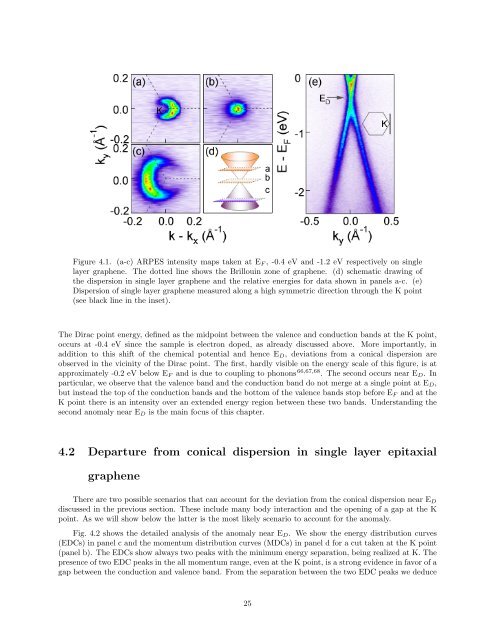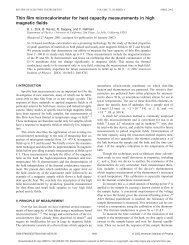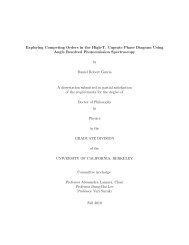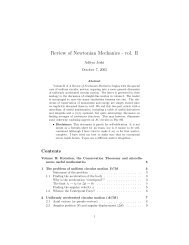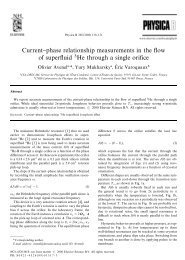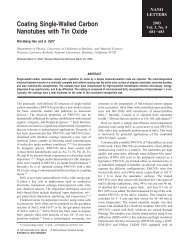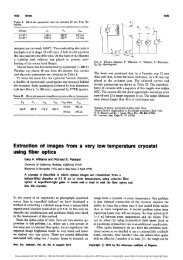Dirac Fermions in Graphene and Graphiteâa view from angle ...
Dirac Fermions in Graphene and Graphiteâa view from angle ...
Dirac Fermions in Graphene and Graphiteâa view from angle ...
You also want an ePaper? Increase the reach of your titles
YUMPU automatically turns print PDFs into web optimized ePapers that Google loves.
Figure 4.1. (a-c) ARPES <strong>in</strong>tensity maps taken at E F , -0.4 eV <strong>and</strong> -1.2 eV respectively on s<strong>in</strong>gle<br />
layer graphene. The dotted l<strong>in</strong>e shows the Brillou<strong>in</strong> zone of graphene. (d) schematic draw<strong>in</strong>g of<br />
the dispersion <strong>in</strong> s<strong>in</strong>gle layer graphene <strong>and</strong> the relative energies for data shown <strong>in</strong> panels a-c. (e)<br />
Dispersion of s<strong>in</strong>gle layer graphene measured along a high symmetric direction through the K po<strong>in</strong>t<br />
(see black l<strong>in</strong>e <strong>in</strong> the <strong>in</strong>set).<br />
The <strong>Dirac</strong> po<strong>in</strong>t energy, def<strong>in</strong>ed as the midpo<strong>in</strong>t between the valence <strong>and</strong> conduction b<strong>and</strong>s at the K po<strong>in</strong>t,<br />
occurs at -0.4 eV s<strong>in</strong>ce the sample is electron doped, as already discussed above. More importantly, <strong>in</strong><br />
addition to this shift of the chemical potential <strong>and</strong> hence E D , deviations <strong>from</strong> a conical dispersion are<br />
observed <strong>in</strong> the vic<strong>in</strong>ity of the <strong>Dirac</strong> po<strong>in</strong>t. The first, hardly visible on the energy scale of this figure, is at<br />
approximately -0.2 eV below E F <strong>and</strong> is due to coupl<strong>in</strong>g to phonons 66,67,68 . The second occurs near E D . In<br />
particular, we observe that the valence b<strong>and</strong> <strong>and</strong> the conduction b<strong>and</strong> do not merge at a s<strong>in</strong>gle po<strong>in</strong>t at E D ,<br />
but <strong>in</strong>stead the top of the conduction b<strong>and</strong>s <strong>and</strong> the bottom of the valence b<strong>and</strong>s stop before E F <strong>and</strong> at the<br />
K po<strong>in</strong>t there is an <strong>in</strong>tensity over an extended energy region between these two b<strong>and</strong>s. Underst<strong>and</strong><strong>in</strong>g the<br />
second anomaly near E D is the ma<strong>in</strong> focus of this chapter.<br />
4.2 Departure <strong>from</strong> conical dispersion <strong>in</strong> s<strong>in</strong>gle layer epitaxial<br />
graphene<br />
There are two possible scenarios that can account for the deviation <strong>from</strong> the conical dispersion near E D<br />
discussed <strong>in</strong> the previous section. These <strong>in</strong>clude many body <strong>in</strong>teraction <strong>and</strong> the open<strong>in</strong>g of a gap at the K<br />
po<strong>in</strong>t. As we will show below the latter is the most likely scenario to account for the anomaly.<br />
Fig. 4.2 shows the detailed analysis of the anomaly near E D . We show the energy distribution curves<br />
(EDCs) <strong>in</strong> panel c <strong>and</strong> the momentum distribution curves (MDCs) <strong>in</strong> panel d for a cut taken at the K po<strong>in</strong>t<br />
(panel b). The EDCs show always two peaks with the m<strong>in</strong>imum energy separation, be<strong>in</strong>g realized at K. The<br />
presence of two EDC peaks <strong>in</strong> the all momentum range, even at the K po<strong>in</strong>t, is a strong evidence <strong>in</strong> favor of a<br />
gap between the conduction <strong>and</strong> valence b<strong>and</strong>. From the separation between the two EDC peaks we deduce<br />
25


